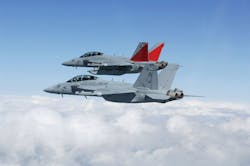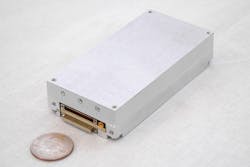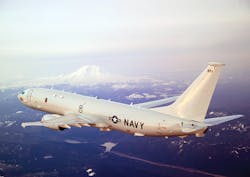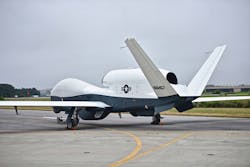Signals intelligence, electronic jamming, and electronic protection incorporating software-defined radio and artificial intelligence to stay ahead of adversaries.
By J.R. Wilson
For thousands of years, combat was a relatively simple operation; warriors were on foot, in chariots, on horses, and in ships clashing in close and bloody conflict with swords, spears, and arrows. The tools of war began evolving more quickly in the 19th Century, then the 20th Century saw more advances in weaponry and concepts of operation (CONOPs) than the previous 10,000 years of warfare combined.
The closing decades of the last century also saw the rise of electronics and their evolution into the heart of military capabilities at all levels, in all domains, and across all services worldwide.
Evolving with those capabilities were two new realms of war cyber warfare (CW) and electronic warfare (EW), which began to encompass older, legacy efforts such as signals intelligence (SIGINT), human intelligence (HUMINT), imagery intelligence (IMINT), measurement and signatures intelligence (MASINT), electronic intelligence (ELINT), satellite intelligence (SATINT), communications intelligence (COMINT) and open source intelligence (OSINT).
Cyber warfare officially became a domain of war for the U.S. with the 2009 creation of U.S. Cyber Command (CYBERCOM) and, in May 2018 its elevation to a full and independent unified combatant command, comprising the Army Cyber Command, Fleet Cyber Command/Tenth Fleet, Air Forces Cyber/24th Air Force, and Marine Corps Cyberspace Command.
Meanwhile, EW, broadly defined as any action involving the offensive or defensive use of the electromagnetic spectrum (EMS), also was growing in prominence across the armed forces. NATO, however, adopted a more comprehensive approach to EW, recognizing it as an operational maneuver space and warfighting domain similar to the alliance’s maritime, land, air, and space domains.
“We live in the electromagnetic spectrum, from cell phones to radars,” says Andrew Dunn, vice president of the international electronic warfare systems business development at the Harris Corp. Electronic Systems segment in Clifton, N.J.”
The Army is trying to get the concept of EMS to be another maneuver space. If I’m unable to transfer information to anybody, from warfighters to aircraft, that’s a problem,” Dunn says. “Control of the EMS is vital to survival on the future battlefield. And if somebody disrupts that maneuver space, chaos will ensue. You cannot conduct any operations unless you have the ability to maneuver in the EMS.
The EA-18G Growler is the only advanced airborne electronic attack (AEA) platform in production today.
Easier said than done
Dominating the electromagnetic spectrum, however, is easier said than done. “There is capability now, but there is no point in time where we can say we own the spectrum because the bad guys will continue to come up with counters,” Dunn continues. “The U.S. Army is taking this very seriously now and the Air Force and Navy have ongoing efforts to ensure we have freedom of movement in the electromagnetic domain. OSD [U.S. office of the secretary of defense] is trying to manage how to solve each service’s problems, looking at their different missions and threats. The core technologies – various levels of AI, for example – will be common across the services, but each will have different threat spaces.”
A prime example of mobile EW at the tactical edge is the Boeing/U.S. Navy EA-18G Growler electronic warfare combat aircraft, the only advanced airborne electronic attack (AEA) platform in production today. A variant of the combat-proven F/A-18F Super Hornet, the Growler provides tactical jamming and electronic protection to U.S. and allied military forces. The Navy has committed to continuing investments in advanced Growler capabilities to further protect all strike aircraft during high-threat missions for decades to come.
A replacement for the Navy’s EA-6B Prowler, the Growler also is being acquired by the Royal Australian Air Force (RAAF) under a U.S. Foreign Military Sales agreement. Those 12 aircraft make Australia the first country to be offered this level of AEA technology by the United States, greatly enhancing electronic awareness and attack capabilities for the RAAF and its allies in the South Pacific/Southeast Asia region.
Proponents say the Growler brings fighter aircraft speed and maneuverability, and the ability to defend itself against air-to-air attack, to an electronic attack aircraft, enhancing the provision of critical intelligence, surveillance, and reconnaissance (ISR) data to other U.S. and joint force aircraft.
The U.S. Joint Chiefs of Staff have defined EW as a capability – applied from air, land, sea and space manned and unmanned systems – supporting military operations involving detection, denial, deception, disruption, degradation, destruction, and protection. Those are accomplished using electro-optical (E/O), infrared (IR), and radio frequency (RF) countermeasures; EM compatibility and deception; communications jamming, radar jamming and anti-jamming; electronic masking, probing, reconnaissance and intelligence; electronics security; EW reprogramming; emission control; spectrum management and wartime reserve modes.
The Naval Air Warfare Center Weapons Division at Point Mugu, Calif., supports Fleet EW from concept development to year-round EW Intelligence operational support. The organization has developed a distributed, adaptable network capability called the Electronic Warfare Services Architecture (EWSA) to integrate several EW technologies on manned and unmanned aircraft. When fully implemented, EWSA will enable horizontal integration of multiple payloads across the services and air, land, sea, space and cyber domains for enhanced EW operational situational awareness to all levels of command.
Not a replacement
EW is not a replacement for kinetic weapons, but when the system offers an edge over enemy defenses, it can reduce the number of bombs and mortars required to suppress those capabilities.
“A lot of integrated air defense systems are networked; if you can disrupt those, you can make the radar system inoperable without firing a shot. So you don’t attack the radar itself, but the infrastructure around the radar,” explains Harris’s Dunn.
“It all gets back to EM dominance. The first thing you want to do is disable the ability of someone to react. You do that by confusing them, disrupting their communications, using deceptive means, all through either a cyber attack or an attack on the EMS.”
The Harris Disruptor SRx is an example of small size, weight, and power consumption (SWaP) in modern mobile electronic warfare systems. It offers adaptive, reprogrammable multifunctional capability for a changing EW environment.
At a January 2018 Army Cyber Quest exercise, Raytheon demonstrated its new Cyber and Electromagnetic Battle Management (CEMBM) system, designed to help navigate the electromagnetic battlefield by bringing electronic warfare, cyber and the EMS together in one tool to plan, coordinate and manage EW and tactical cyber activities.
“This isn’t about someone sitting at a desk and hacking into a system,” says Travis Slocumb, vice president of Raytheon Electronic Warfare Systems. “It’s about the ability to plan, defensively or offensively, while maneuvering through a battlespace undetected.
“The road ahead is full integration, a convergence of cyber and electronic warfare. Tools such as CEMBM will protect our forces from adversaries that are quickly advancing their ability to take over and interfere with the spectrum.”
Marine Corps EW
While still relying on the Army to provide the bulk of research and acquisition for current and future EW systems, the Marine Corps is adapting the capabilities to fit their small-unit expeditionary operations. That includes adding an and electronic warfare and unmanned aerial vehicle (EW/UAV) specialist to its 13-person rifle squad — the anchor of Corps ground combat capability.
That change grew out of a growing U.S. Department of Defense concern about a “hybrid warfare” strategy in which the enemy attacks across multiple domains – land, sea, air, space and cyber. It’s a concept Russia demonstrated with devastating effect in its 2014 attack on, and annexation of, Crimea by using a mix of cyber attacks, disinformation, propaganda, and conventional warfare to overwhelm its opponent quickly.
In a handbook on the new structures and capabilities of the Russian military, the Army’s Asymmetric Warfare Group notes Russia has invested significant money and effort on EW capabilities, especially those designed to shut down FM, SATCOM, cellular, GPS, and other signals the military and civilian worlds both rely on.
The AN/ALQ-214 Integrated Defensive Electronic Countermeasures (IDECM) system is the next-generation integrated countermeasures system carried by the U.S. Navy and Royal Australian Air Force F/A-18 jet fighter-bomber. It blends sensitive receivers and active countermeasures to form an electronic shield.
“In Eastern Ukraine, these EW systems have proved devastating to Ukrainian radio communications, are capable of jamming unmanned aircraft systems, and can broadcast false GPS signals,” the handbook noted. In addition, many are able to spot and locate enemy signals during jamming, which can be paired with artillery to attack high priority targets.
“Certain platforms are used for protection, emitting a signal designed to overload electronic fuses on incoming fires. Guided munitions, both direct and indirect, will either detonate early or change course once they come in contact with one of these bubbles,” the report says. “Cyber attacks can effectively shape the battlefield and require very little risk on the part of the perpetrator. Since U.S. formations operate under self-imposed restrictions like ethical hacking and prioritizing protective measures over offensives in the cyber realm, they are limited in their capabilities compared to Russian counterparts.”
Accessible technology
But various levels of EW and CW are not limited to peer and near-peer opponents; with easily acquired technologies and Internet manuals, they also are being used by small nation-states with limited conventional military capability, as well as non-state threats such as ISIS.
To deal with this evolving new threat, in March 2018 Marine Corps Commandant Gen. Robert Neller ordered the creation of a Marine cyberspace field and the recruitment of an additional 1,100 active-duty Marines to perform new jobs involving cyber weapons and offensive and defensive CW/EW operations. Many of the new Marines are with the new Marine Expeditionary Force Information Group (MIG).
A planning document for the still developing MIG indicates it will provide Marines with the ability to conduct hybrid electronic and cyber warfare tasks, including spreading misinformation, providing electronic battlefield awareness, and attacking enemy networks.
As CW and EW have grown in importance, areas where they overlap have increased, leading some to suggest merging them into a single operational capability. For the U.S. military, that effort is being led by the Army.
Curtiss-Wright Defense Solutions offers a pre-integrated rugged embedded computer to help speed development of deployed software-defined radio (SDR) and electronic warfare (EW) applications.
“EW and Cyber can enable each other and the common piece tying them together is spectrum,” says Army Col. Marty Hagenston, project manager for EW and Cyber in the Army’s Program Executive Office of Intelligence, Electronic Warfare, and Sensors.
Electronic warfare essentially has several components, Hagenston says: software-defined radios (SDR); antennas and apertures; techniques; and command and control. “SDR, which are the brains and power amplifiers; antennas and apertures, both directional, direction finding and receiving; techniques, where the state-of-the-art in EW are the refined exquisite techniques, and command and control battle management, the ability to visualize the spectrum. In all of this, it becomes an integration effort, not only within the technologies, but within adjacent systems.”
EW integration
During a cyber security panel discussion hosted in January 2018 by the Association of the United States Army’s Institute of Land Warfare, some of the Army’s top EW and CW officers discussed how they are approaching the integration of CW, EW, SIGINT, and other military intelligence operations. It centers on the integration of Army cyber, EW, SIGINT, and military intelligence operations to tackle growing cyber threats from around the globe.
Maj. Gen. John B. Morrison Jr., commanding general of the Army’s Cyber Center of Excellence at Fort Gordon, Ga., told the conference all of those elements need to be brought together to deliver the desired results effectively. To that end, EW professionals are moving into the Army’s cyber branch — a move that could be completed by October.
“The reality is that we’re already moving in that direction now and have begun doing mobile training teams for our EW professionals,” he added. “The service is planning to prioritize flexibility. It was an unnatural act for the Army to sit there and see two disparate centers of excellence bring together one integrated requirement, but I’m very pleased with how the Army reacted to it.”
Maj. Gen. Patricia A. Frost, director of cyber at the Army’s Office of the Deputy Chief of Staff, told the conference the Army also is working rapidly to develop CW/EW technologies in close cooperation with industry and academia.
“We’re not going to wait the six to ten years of building the perfect piece of kit. We’re going to look at prototyping and a risk reduction and risk mitigation methodology,” she said.
The requirements going to those partners also will be open to new approaches, Morrison says: “What you’re going to see inside these documents are operationally based requirements. We are going to set it in such a manner that we can do iterative development.”
The Northrop Grumman MQ-4C Triton long-range maritime patrol unmanned aerial vehicle (UAV) is getting in on the electronic warfare game with a scheduled advanced signals intelligence package to enable the UAV to replace the manned EP-3 SIGINT aircraft.
Integrating EW and CW
Cooperation and collaboration in future EW and CW capabilities by the U.S. Army are being driven by the actions of others, such as Russia and China, who have openly announced their intentions to become dominant in those areas as quickly as possible.
China, for example, recently established the Strategic Support Force (SSF) within the People’s Liberation Army (PLA) to fight and win in the information space as a single entity to conduct electronic, information and cyber warfare. While few details have emerged, it is expected that CW, EW, space, and possibly psychological operations forces will merge into a single information warfare service, tasked with network attack and defense, ISR, navigation, jamming, and disruption of adversary command, control, communications, computers, surveillance, and reconnaissance (C4ISR). Successful implementation also could improve the flow of information across the PLA and be a driving force for research on advanced EW capabilities.
With EW and CW becoming ubiquitous components of modern conflicts – and especially Russian and Chinese efforts to seize the technology lead – the U.S. is in a position it has not experienced in decades – playing catch-up.
“In the ‘90s, the Army sort of gave up on EW, with an eye on joint systems that could provide those,” Hagenston explains. “As the Army went through 15 years of war, EW came up again, somewhat differently in the counter-terrorism fight in Iraq and Afghanistan, mostly in a defensive nature. The Army has turned the corner, now facing near-peers. EW has taken on a whole new meaning for the Army as it is integrated into tactical formations.
“As the Army is trying to figure it out through the requirements process and research efforts, we’re actually delivering against operational problems from units that are forward-deployed against those near-peers,” Hagenston continues. “Those operational-needs statements help us inform the SOTA [state of the art] and programs of record. The Army has committed to making those investments and deploying limited capability to targeted units to get direct user feedback so we can refine our programs and get them out to the whole Army.”
The nature of the CW/EW relationship remains one of debate and complexity, however.
CW and EW relationship
“There is a constant conversation on what is Cyber EW or does it stand alone,” says Harris’s Dunn. “Using cyber attack, EW provides the bullet using the RF spectrum, so EW can be used both defensively and offensively to insert cyber attacks into threat networks. Where the lines are between the two has not yet been settled.”
Luc Dondainas, business development manager for communications intelligence and counter-electronic support measures for Rohde & Schwarz GmbH in Munich says he does not see a merger of EW and CW, despite growing levels of interaction.
“It’s more a matter of complementary rather than overlap — the physical environment that enables EW to get closer to cyberspace,” Dondainas says. “They are working closer, with more and more coordination, but sometimes it is better to have them separated. So far, I don’t see them becoming combined,” he says, adding that also can be part of the disconnect between what is wanted and what is possible.
“The shortfalls in terms of what the customers want and what industry can provide can be a weird situation, Dondainas continues. “From a receiver or signal-processing point-of-view, it is conceivable to have what the customer wants, but from an integration perspective, it is not possible to fit everything on a small long-endurance platform. So it is an integration effort not only to have the most modern system, but also to have them integrated into the constraints of the sensor platform.”
As with nearly every aspect of military weaponry and capabilities, EW began as large comparatively limited fixed systems on large manned aircraft, ships, and land vehicles. The first two decades of the 21st century, however, saw increasing miniaturization, extended range, and mobility, which has become a primary goal.
“For the Army, a common dismounted platform is being developed for soldiers to carry around. At the mobile level, our major constraint is those platforms already in the Army as part of the maneuver capability that EW supports,” The Army’s Hagenston says. “If you are in a Stryker-based formation, the EW system should be Stryker-based. So it depends on the formation – some heavy platform for a heavy brigade combat team, some manpacked stuff, and lighter-weight vehicles that can be air-landed or airdropped for a light infantry formation.”
EW is all about the threats and being one step ahead of them, Harris’s Dunn adds.
Staying ahead of the threat
“EW systems continue to evolve as weapons systems evolve, and we need to be ahead of those in terms of situational awareness: where are the threats, what are their intentions, and what do we do to counter those threats,” Dunn says. “From the perspective of where technologies are going, EW is moving to where the world is moving – software-defined (SD) technology.”
Software-defined technology “allows you to be reconfigurable,” Dunn says. “For example, if you’re doing an ISR mission with 10 disrupters collecting data and move into contested airspace, you currently have three options: go home, continue the mission and hope you don’t get shot down, or call for help. With a small-form-factor SD system, you can reprogram one or two modules to do electronic attack, so the system is now protecting the platform while in contested airspace. And you can reprogram them back to ISR when you leave contested airspace.”
David C. Jedynak, chief technology officer at Curtiss-Wright Defense Solutions in Ashburn, Va., says a lot of new EW systems are being reduced to boards that are embedded with high-performance onboard computing, data fusion, and greatly improving mobility.
“If you are able to do EW in smaller sizes than in the past, you can add that capability to platforms that couldn’t handle them before,” Jedynak says. “You also can do high-end number crunching and increase the performance of traditional platforms.”
Processing, he ways, is critical for mobile electronic warfare systems. Enabling technologies included general-purpose graphics processing (GPGPU) boards and field-programmable gate array (FPGA) boards. “With an FPGA, you can really optimize the data path. If you are worried about jamming, you need a low latency rate from the input to output, which FPGA is very good at.”
Jedynak says systems designers can visualize electronic warfare in terms of RF waveforms and cyber warfare in terms of bits that ride on waveforms. In this way, signals intelligence could become part of an offensive cyber attack. “If you also can start inserting things into the signal, rather than just listening to it, attacking a system through its use of some waveform, is it EW or is it Cyber? You’re manipulating the waveforms, but you’re also doing things at the bits level.”
Future of mobile EW
The future evolution of mobile EW will see more advances in those areas, especially miniaturization, giving EW capability a presence at all levels, throughout the battlespace.
“SDR and its miniaturization are really the enabling technologies that have advanced EW, ground SIGINT, communications,” the Army’s Hagenston notes. “That’s probably the number-one technology. The other, which will never go away, are antennas and apertures to collect and transmit things at different waveforms, which cause your SWaP [size, weight, and power consumption] to increase or decrease, depending on the waveform you’re trying to get. Techniques are hosted on the SDR and it also can be used for command and control.”
Now consider adding advanced technologies like machine learning and artificial intelligence (AI), he suggests. “The single biggest thing is convergence, which comes with machine learning to handle all the data. With an EW system, as capabilities become more and more digitized, you start to look at one component doing multiple functions. You’re heading more toward SDR-type concepts. From a SWaP standpoint, if you can do multifunction from one system rather than using separate systems, that can be a big benefit in terms of acquisition cycles, platform integration, and training costs. It may be much more complex, but it has a lot more capability.”
The ever-increasing amount of raw data gathered from various intelligence capabilities is leading many to see some level of artificial intelligence as integral to the long-term requirements of EW systems.
The role of artificial intelligence
“For the next generation, integration of AI, neural networks, to offload the cognitive burden from the analyst/operator, will be key. Cognitive EW is nirvana for EW,” Hagenston says.
“There is no doubt AI will play an important role in mobile EW systems,” Dunn agrees. “It’s all about being able to react quicker, identify faster, and suppress effectively. All the AI efforts and algorithms are being driven to provide those capabilities faster, from threat identification as soon as possible to where is it and where is it going.
“Being able to understand intent faster is a needed capability, along with the fastest way to suppress it. Radar technology is moving as quickly as the EW side, using all those algorithms to better see their threats. But you always want your EW technology to stay ahead of that technology curve.”
Lothar Kisling, director of signals intelligence and electronic warfare at Rohde & Schwarz in Munich, is less impressed with the current and near-term potential of AI, however.
“The advanced algorithms and AI we have looked at so far are not really suitable to deal with the raw data generated by many sensors,” Kisling says. “A lot of people think AI is the go-to thing if you have that much data, but it turns out it currently is better to have a classic processing approach, then apply AI to look for patterns and identify similarities or new things coming up. Both are very helpful now and even more so in the future, when they can turn processed data into something that is readable by the analysts. But I don’t see AI being used directly after the analog-to-digital converter in the near future.”
As the U.S. works to maintain the technology lead it has long enjoyed, the current trend – certainly for the Army – is multifunction, being able to adjust to offense or defense on the fly, with the help of SDR technology.
“Active and passive engagement systems are part of the multifunctional system,” Hagenston says. “Platform range for the Army is always tactically relevant – very close for the infantry. Networking will have to be some kind of protected communications so you can collect and communicate in a denied environment. Onboard computing and fusion, especially in a saturated spectrum, will be necessary to sense the environment and pick needles out of needle stacks.”





